Assessing the Worth of Labradorite Gemstones
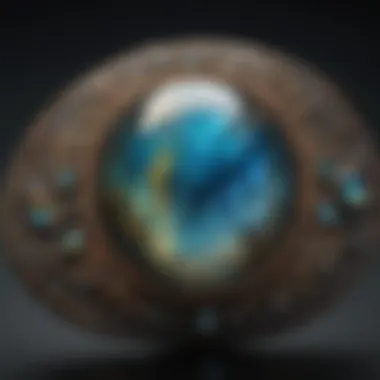
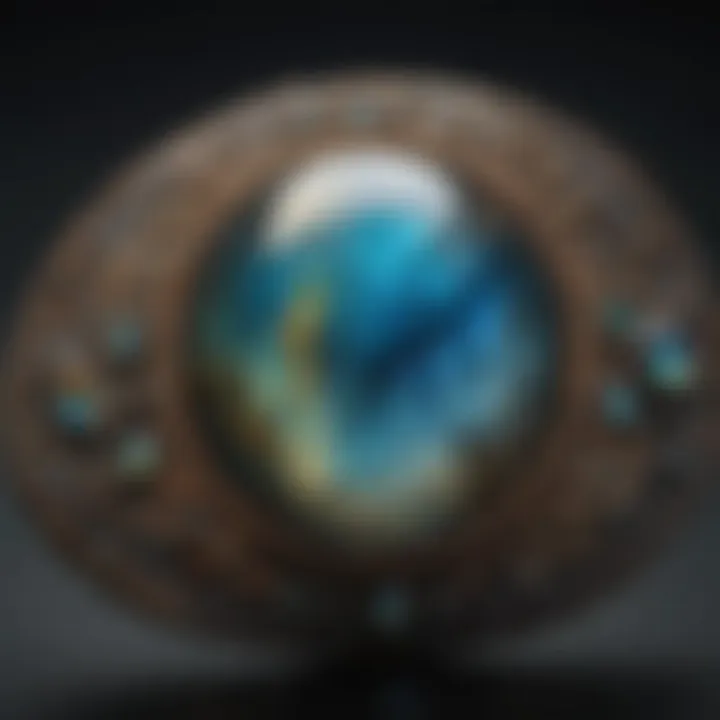
Intro
Labradorite is not just another stone tucked away in a jewelry box; it's a mesmerizing spectacle of nature's artistry. The gemstone, with its distinct interplay of colors, sparks intrigue among collectors and gemstone aficionados alike. To understand its true essence and value, we must delve into various factors that influence its pricing, grading, and cultural significance.
Gemstone Overview
In simple terms, a gemstone is a piece of mineral crystal that, when cut and polished, is used to make jewelry or other adornments. But labradorite stands apart due to its unique visual characteristics. The iridescent quality provides a visual treat, often seeing flashes of blue, green, and gold. This phenomenon is caused by light refracting within the stone's layers, allowing it to change colors depending on the angle of light.
Definition of Gemstones
Gemstones can be categorized as precious or semi-precious. While the top-tier sapphires and diamonds brag about their scarcity and high demand, semi-precious stones like labradorite are appreciated for their beauty and affordability. Consequently, labradorite has carved a niche of its own, attracting both budget-minded buyers and those seeking something distinctive.
Classification of Gemstones
The classification of gemstones generally involves various criteria: type, color, clarity, cut, and carat weight. In the context of labradorite, the emphasis lies on its color and play of light. Ideal specimens should exhibit a vivid labradorescence—those compelling flashes of color that seem to dance across the surface. Aspects like inclusions and surface imperfections often come into play when assessing its overall quality.
"Labradorite's enchanting colors reflect not just light, but the soul of those who wear it."
Historical Significance
The allure of labradorite stretches back to ancient times. This section will delve into its origins and its cultural significance, providing a deeper appreciation for the stone.
Origins of Gemstone Use
Historically, labradorite was first discovered in the late 18th century in Labrador, Canada. Indigenous tribes revered it for its supposed magical properties. They believed it held the essence of the Northern Lights, linking it to various myths and stories. Over time, labradorite became an essential part of the jewelry-making process, gracing pendants, rings, and more.
Cultural Insights: Gemstones in Ancient Civilizations
In diverse cultures, gemstones have been more than just adornments; they served as talismans, symbols of status, and forms of currency. Ancient Egyptians used gemstones for both aesthetic purposes and spiritual significance, crafting intricate jewelry featuring lapis lazuli and turquoise. Similarly, labradorite found its place within cultural lore, believed to enhance intuition and inner strength, making it popular among shamans and healers.
This exploration of labradorite's history and characteristics lays the groundwork for understanding its current market value and potential.
Understanding Labradorite
Labradorite, with its mystical appearance, is not just another gemstone; it's a veritable kaleidoscope of color and light. Understanding this gemstone is crucial for anyone who seeks to appreciate its value or incorporate it into jewelry designs. Not only is it known for its stunning visual appeal, but its unique properties and geological history add layers of depth to its significance.
When discussing labradorite, one digs into aspects such as how it formed under geological processes and what gives it those enchanting hues. Recognizing these distinguishing factors is essential for collectors and designers alike. This gemstone is a blend of beauty and rarity, making it a sound choice for seasoned enthusiasts and newcomers to the field.
Being aware of labradorite's features can help potential buyers identify quality stones, as well as appreciate the artistry involved in jewelry design. As such, one's understanding of this gemstone forms the foundation for evaluating its worth effectively.
Geological Formation
Labradorite emerges from the depths of the earth, primarily found in igneous rocks. Its formation occurs during the slow crystallization of magma. This process often takes millions of years and gives rise to its distinctive features. Its presence is notably prominent in regions like Canada, particularly in the Labrador Peninsula, from which it gets its name.
Such geological nuances are not just a trivial background story; they underscore the rarity and authenticity of the stone. Understanding where the labradorite originated provides insights into its character and value in the market.
Physical Characteristics
The allure of labradorite isn't solely in its origin; its physical characteristics play a significant role as well. Its visual traits encompass a variety of elements that make it highly sought after.
Color Variations
Labradorite showcases a breathtaking spectrum of colors. Predominantly, it can exhibit shades of blue, green, gold, and even purple. The interplay of light on the surface creates a phenomenon many refer to as labradorescence. Each stone is unique, reflecting different colors depending on the angle of light. This striking characteristic contributes to its desirability, attracting both collectors and designers.
Choosing labradorite for a piece of jewelry adds a vibrant touch that few other gemstones can rival. Furthermore, its diverse colors can complement various skin tones and styles, making it a versatile choice.
Labradorescence
Labradorescence is, without a doubt, the showstopper when it comes to this gemstone. This effect is the interplay of light creating iridescent flashes that dance across the surface of the stone. When observing labradorite, one might notice that different angles reveal varying shades, adding to the stone's charm.
This unique feature captures attention, creating a visual experience that constantly shifts. Such a striking characteristic can enhance jewelry pieces, making them memorable. However, labradorescence can sometimes be tricky, as not every labradorite stone displays it equally. Hence, buyers should approach with a discerning eye to evaluate this quality effectively.
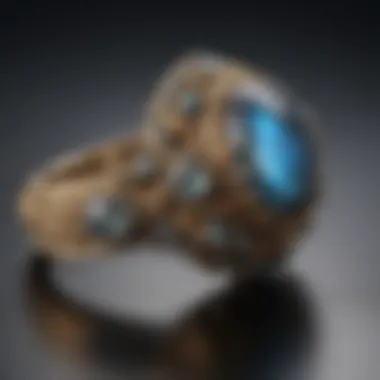
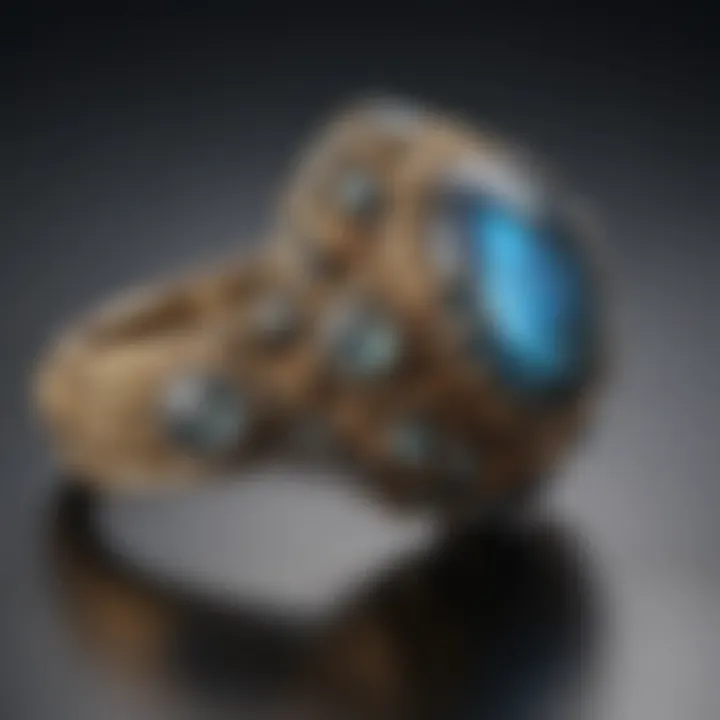
Factors Influencing Value
Understanding what drives the value of labradorite is critical for both collectors and investors. The allure of this remarkable gemstone lies not just in its visual appeal, but in a multitude of aspects that contribute to its overall worth. This section dives into the primary factors that influence the value of labradorite: color and clarity, size and weight, and cut quality. By assessing these elements, one can better navigate the complexities of the gemstone market and make informed decisions.
Color and Clarity
The color and clarity of labradorite are arguably the most critical factors in determining its value. When discussing color, labradorite typically showcases a spectrum that ranges from grey to blue or even green, with the most prized pieces displaying vibrant flashes of blue, gold, or even rare colors like red and purple. This phenomenon, known as labradorescence, occurs when light interacts with internal structures within the stone, creating an optical illusion that can bring the gemstone to life.
"The unique play of colors in labradorite can transform a seemingly ordinary piece of stone into something extraordinary."
When it comes to clarity, the fewer the inclusions or blemishes, the more valuable the gemstone is likely to be. Stones that are nearly flawless are a rare find and command a higher price point. Enthusiasts seeking high-quality labradorite should aim for gemstones that balance vivid color and high clarity, as this combination can lead to a striking visual experience that enhances the stone’s appeal.
Size and Weight
The value of labradorite is also significantly influenced by its size and weight. Generally, larger pieces tend to be more desirable, with larger stones often appearing more impressive and visually captivating. However, weight isn’t just about how big the stone is; the density of labradorite plays a role too. Heavier stones can hold more color and depth, thus enhancing their visual impact. Yet, one should not overlook the quality of the stone. A smaller, high-quality labradorite with vibrant colors may rival larger, less impressive pieces of the same material in terms of value.
When considering size and weight:
- Larger stones can capture more attention and create immediate interest.
- Smaller, high-quality pieces can be more valuable if they exhibit extraordinary color or clarity.
- Weight can impact not only the visual attributes but also the pricing, as many compared grams per carat when evaluating stones.
Cut Quality
Cut quality is another essential element that can make or break the value of labradorite. A well-cut gemstone can enhance the play of color, showcasing the iridescence that labradorite is renowned for. Skilled lapidaries know how to maximize the natural beauty of the stone, transforming it into an eye-catching piece of jewelry.
Poorly cut labradorite may fail to reflect light in the same way that a fine cut would, thereby diminishing its overall appearance and, consequently, its value. Considerations regarding cut quality include:
- Symmetry and proportions: The stone should be well-balanced to allow for maximum light reflection.
- Polish: A high-quality polish can enhance the labradorescence, making the colors more vibrant and appealing.
- Style of cut: Whether it’s a cabochon, a facet cut, or something else, the style can also dictate how effectively the stone displays its unique features.
In summary, evaluating the factors that influence the value of labradorite requires a keen eye for detail and a solid understanding of the gemstone's unique properties. By focusing on color and clarity, size and weight, as well as cut quality, enthusiasts and investors can appreciate not only the beauty of labradorite but also the nuances that contribute to its market value.
Market Demand and Trends
Understanding market demand and trends is crucial when navigating the world of labradorite. As with any gemstone, the value often hinges on the perceptions and desires of collectors, gem dealers, and jewelry designers. The allure of labradorite, with its striking colors and unique optical phenomena, can fluctuate based on fashion, availability, and cultural tendencies. By grasping the nuances of market trends, enthusiasts and investors can make informed choices that enhance their collections or portfolios.
Current Market Insights
The ongoing exploration of labradorite’s market status reveals a tapestry woven from various threads—popularity, supply, and emerging styles. Recently, labradorite has seized the attention of jewelry markets, particularly among those who favor its organic charm and mystical associations. Listed below are some key insights:
- Increased Awareness: Social media, particularly platforms like Instagram and Pinterest, showcase beautiful labradorite pieces, amplifying its desirability among younger buyers.
- Sustainability Appeal: As ethical sourcing grows in importance, many customers seek out gemstones they can trace back to reputable mines. Labradorite fulfills this criterion well, often sourced responsibly, which further enhances its appeal.
- Distinctive Aesthetic: Unlike gemstones that are cut for brilliance and clarity, the irregularities in labradorite are celebrated. Designs that emphasize its natural inclusions attract a clientele looking to stand apart from mainstream trends.
To summarize, current market insights show a positive trend for labradorite, signifying its potential for financial growth while remaining a unique addition to personal collections.
Comparative Value with Other Gemstones
When comparing labradorite with other precious and semi-precious stones, its value can fluctuate based on several criteria. While diamonds and sapphires may dominate high-end spending, labradorite offers an attractive alternative for budget-conscious consumers looking for beauty without the hefty price tag. Consider these points when evaluating its worth in relation to other gemstones:
- Cost-Effectiveness: Labradorite generally costs significantly less than more traditional gemstones, making it an accessible option for many buyers.
- Rarity and Availability: Despite its growing popularity, labradorite is less common than stones like quartz and amethyst. Hence, rare color shifts or exceptional specimens can command robust prices.
- Market Niche: The niche status of labradorite allows it to exist in a space distinct from well-recognized gemstones. This aspects helps engender a loyal following among collectors who desire the unique properties that labradorite embodies.
"The comparative value of labradorite lies not just in its monetary worth, but in its ability to transcend traditional market expectations and appeal to those who value individuality and character in gemstones."
In summation, understanding the market demand and trends surrounding labradorite not only informs investors and collectors but allows them to appreciate the stone's broader significance in the jewelry landscape.
Evaluating a Labradorite
Evaluating a labradorite is a crucial step for both enthusiasts and investors alike. The value of this gemstone stems not just from its beauty, but also from various elements that contribute to its overall worth. Understanding how to judge a labradorite's worth can provide insights into making informed decisions whether you're buying or selling.
Many factors affect a labradorite's value, including its color, clarity, cut, and the current market trends. Judging these aspects appropriately holds the key to unlocking the true potential of one's investment. The deeper one dives into understanding these elements, the more advantages they have when navigating the complex waters of the gemstone market.
Furthermore, a well-evaluated labradorite could make a significant difference in terms of resale value. Buyers, especially those who appreciate gemstones, are often willing to pay a premium for pieces that are not only visually stunning but also possess the characteristics that denote their rarity and quality. Knowing how to evaluate a labradorite allows one to appreciate its intricate details, ultimately enhancing one’s connection to the stone and its historical narrative.
Professional Grading Systems
Professional grading systems serve as essential tools in the evaluation process of labradorite. These systems provide a standardized methodology for assessing various gemstone qualities. Notably, they measure color, clarity, and overall aesthetic appeal.
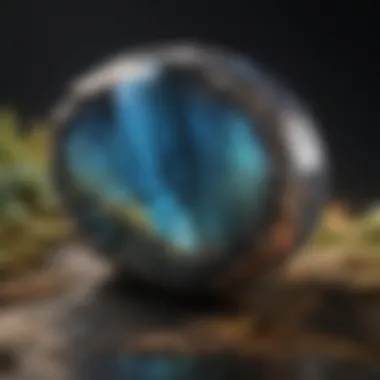
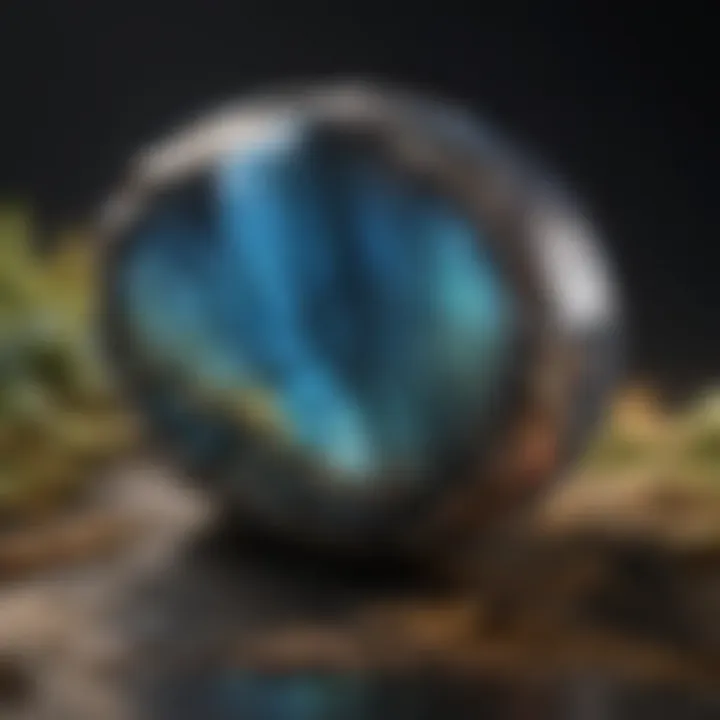
Some of the reputable grading systems include the Gemological Institute of America (GIA) and the American Gem Trade Association (AGTA). Here are some criteria you might encounter when reviewing a labradorite's grade:
- Color Quality: The hue, saturation, and evenness.
- Clarity: The absence of inclusions and surface blemishes.
- Cut: How well the stone has been fashioned and polished.
- Carat Weight: Size matters, and this is a crucial factor in grading.
Using professional grading can bring transparency to gemstone transactions, as buyers are more confident when they know a piece has met certain standards. That said, each grading system carries its nuances, so honing in on the specific criteria of the grading body is key.
Independent Appraisals
Independent appraisals are another vital aspect when it comes to evaluating a labradorite. Unlike grading from professional bodies, independent appraisers offer a subjective perspective based on their expertise and experience. This can be particularly beneficial for individuals looking to understand the value of their personal collection or for those eyeing additions to their stash.
When considering an independent appraisal, pay attention to the following:
- Experience of the Appraiser: Look for certifications and a strong background in gemstones.
- Previous Work Samples: A portfolio can provide insight into the quality of their evaluations.
- Reputation: Check reviews or ask within communities, such as on Reddit, to discover opinions.
Independent appraisals may also take into consideration market demand, which can fluctuate greatly.
"The worth of a labradorite may not just be in its appearance but also in the narrative it carries through its appraised value."
The Role of Certification
When it comes to precious stones like labradorite, the role of certification cannot be emphasized enough. Certification serves as a stamp of authenticity, providing both buyers and sellers peace of mind regarding the quality and value of the piece in question. In a market filled with imitation and misrepresentation, certification can significantly influence decision-making, particularly for collectors and investors who aim to get the most bang for their buck.
The benefits of certification stretch beyond just confirming authenticity. Well-established certification bodies evaluate gemstones according to rigorous standards, focusing on aspects like color, clarity, and cut quality. This detailed evaluation leads to grading, which in turn helps to set transparent price points based on market demand and rarity. By having a certified gem, buyers are not only assured of its quality but also its provenance, which is crucial in building a long-term investment portfolio.
Understanding Certification Bodies
Among the notable certification bodies in the gemstone market are the Gemological Institute of America (GIA) and the International Gemological Institute (IGI). These organizations have built a solid reputation through their systematic and objective grading processes. It's worth noting that each certification body employs slightly different grading standards, which can lead to variations in the value assigned to a particular piece of labradorite.
When selecting a certification body, it is essential to consider factors such as:
- Reputation: Established institutions are generally more reliable.
- Grading Criteria: Different bodies use varied methods for evaluation, which can affect the outcome.
- Transparency: This involves an easy-to-understand grading report to educate the buyer on what the evaluation entails.
It's advisable to familiarize oneself with these bodies and their respective grading scales to better assess the value of a labradorite gemstone accurately.
Impact of Certification on Value
A certified labradorite often carries a higher price tag compared to its non-certified counterparts. But why is that the case? A piece that comes with a certificate of authenticity is more likely to be perceived as valuable due to the documentation supporting its qualities. This paperwork effectively acts as a guarantee for the buyer, adding credence to the pricing.
From an investor's perspective, certified labradorite may appreciate over time more reliably than non-certified stone. When auctions roll around or when you're looking to make a sale, having the gemstone certified enhances its marketability. In summary, the impact of certification on value can be summed up as follows:
- Increased Trust: Buyers are more inclined to spend on certified items.
- Market Standards: Sets benchmarks for quality which can help mitigate price manipulation.
- Provenance Assurance: Confirms the origin and history of the stone, making it more appealing to those in the market.
"Certification transforms a beautiful stone into a confidently treasured asset, paving the way for future appreciation and trust in its value."
In short, the role of certification in the realm of labradorite not only safeguards consumer interests but enhances the desirability and, subsequently, the value of the gemstone. Understanding this relationship is crucial for both jewelers and enthusiasts alike.
Labradorite in Jewelry
Labradorite holds a unique position in the jewelry world, making it more than just a pretty stone. Its captivating play of colors, known as labradorescence, creates a visual feast that many ardent collectors and casual admirers find irresistible. More than surface beauty, the qualities of labradorite lend themselves to specific design applications, enabling jewelers to articulate a story while enhancing personal expression through jewelry.
One vital consideration for jewelry enthusiasts is how labradorite interacts with different designs. Unlike more common gems, such as diamonds or sapphires, labradorite often breathes into a garment or accessory, providing an artistic flair that can elevate simple pieces into something striking. The variability in its appearance—flashing hues of blue, green, gold, and sometimes even pink—creates endless potential for creativity. Therefore, jewelers can play with settings that maximize these colors, often preferring minimalist designs that allow the stone to showcase its natural charisma.
"Labradorite is like a dance of colors—sometimes elusive and sometimes bold, it offers a new surprise each time you gaze upon it."
This duality inspires a range of design trends that, while rooted in traditional aesthetics, also embrace modernity. Ancient cultures revered labradorite, incorporating it into talismans and amulets, and today, it has transitioned into everyday wear as fashion turns towards unique, expressive pieces. So, whether it be through earrings, necklaces, or bracelets, each piece has the potential to convey a story.
Design Trends
Throughout the years, trends regarding labradorite in jewelry have evolved, reflecting broader movements in fashion and consumer preferences.
- Nature-Inspired Designs: With today’s heightened interest in the environment, many designers are opting for organic shapes in their jewelry lines. Labradorite’s shimmering tones often mimic nature’s palette, making it an ideal candidate for these designs.
- Layering and Stacking: Another current trend involves layered or stacked jewelry. Combining various textures, sizes, and colors with labradorite pieces has seen a surge, allowing individuals to mix and match for a personal touch.
- Art Deco Influences: Some contemporary jewelry showcases a return to geometric and symmetrical patterns, characteristic of the Art Deco movement. Labradorite’s multifaceted appearance fits seamlessly into these designs, offering a retro yet fresh vibe.
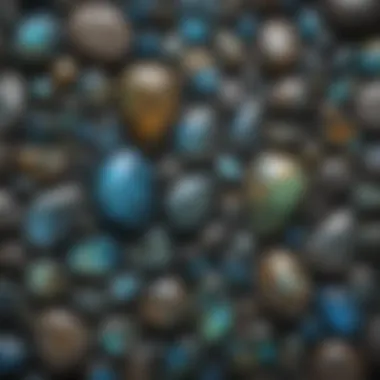
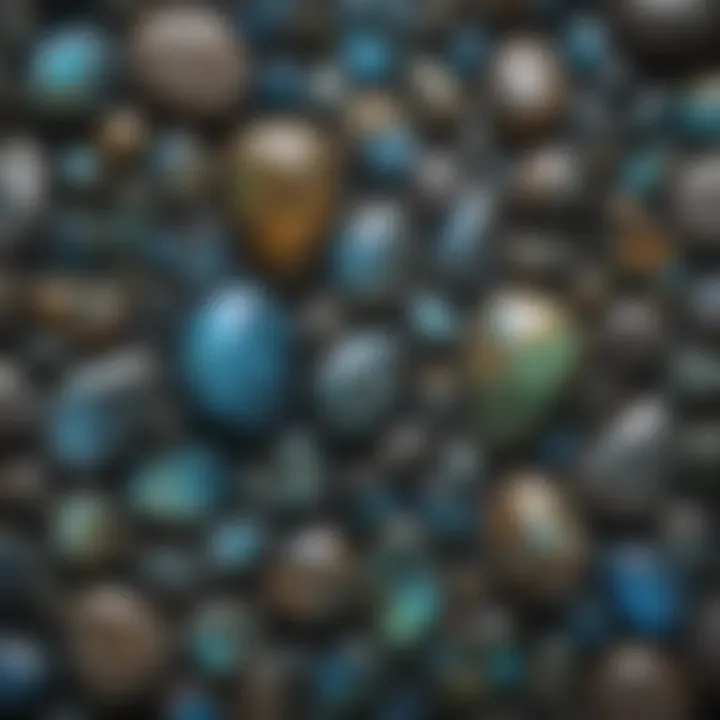
These trends not only reflect aesthetic preferences but also a shift towards individuality and storytelling through fashion.
Popular Jewelry Styles
When discussing jewelry styles that prominently feature labradorite, several designs consistently stand out:
- Statement Rings: A colorful labradorite set in bold metals like silver or gold commands attention. These rings often become conversation starters, as their shimmering colors pull the eye.
- Dramatic Necklaces: Long, flowing necklaces made with labradorite beads or pendants allow the stone's unique properties to shine. They are perfect for layering or making a statement on their own.
- Earrings: Drop and stud earrings featuring labradorite play with light and motion, often giving wearers a little magic in their everyday outfits.
- Bracelets: Multi-stone bracelets that combine labradorite with complementary gemstones create exciting patterns and textures on the wrist.
With so many styles available, labradorite has carved a niche for itself, appealing to diverse tastes and preferences. Wearers not only enjoy the beauty but also revel in the stone's fascinating background, creating an experience that’s as rich as the jewel itself.
Investment Potential
When it comes to understanding the significance of labradorite as an investment, one must consider several layers of its appeal. The gemstone is not just a delightful adornment; it conceals potential for appreciation in value over time. For collectors and investors alike, acknowledging this duality is vital.
Labradorite's unique optical phenomena, often described as labradorescence, is one of the reasons it stands out in the crowded gemstone market. Unlike your ordinary gemstones, labradorite dances with colors that shift and shimmer, captivating the eyes of many. However, the investment potential stretches beyond aesthetics—its geological rarity and distinctive characteristics establish a firm foundation.
Investors often seek stones that promise both emotional satisfaction and financial returns. The market for labradorite remains somewhat niche, yet it has shown resilience, particularly among enthusiasts keen on sourcing unusual gems. The growth in demand for ethically sourced and unique gemstones, coupled with labradorite's attractive qualities, paints a promising picture for investment prospects.
Considering Labradorite as an Investment
Evaluating labradorite from an investment standpoint involves a clear-eyed assessment of several key factors. First and foremost, the gemstone's emotional and symbolic allure tends to add a layer of value that is often overlooked. Owning a piece of labradorite goes beyond mere possession; it's about possessing a slice of the earth's history and beauty.
- Market Trends: Keeping a pulse on current market trends can inform buyers on when to invest. As with any market, fluctuations do occur, influenced by fashion trends, cultural shifts, and global events. Investors should take note of how often labradorite appears in high-end jewelry collections or exhibitions, as trends can propel a stone’s worth significantly.
- Quality Matters: The grading of labradorite is crucial. Superior specimens—those that are large, have high clarity, and display vibrant colors—are likely to appreciate more than lower quality stones. Buyers should arm themselves with knowledge of what differentiates a good stone from a mediocre one.
- Long-term Holding: Given that labradorite is often subject to market whims, it's advisable to view it as a long-term investment. While short-term gains are possible, patience may yield better rewards as the stone continues to grow in popularity.
Ultimately, the decision to invest in labradorite should be a balance between emotional connection to the stone and pragmatic considerations of market dynamics.
Historical Appreciation Trends
Looking back at the historical trends can give investors invaluable insights regarding labradorite's trajectory. The gemstone first caught the world’s attention in the 18th century, thanks to its striking visuals; it’s not merely a flash in the pan but has sustained interest through various eras.
- Initial Popularity: Labradorite was heralded as a discovery early on, and over time, it transitioned from curiosities in gem collections to being featured in prestigious jewelry designs.
- Modern Resurgence: In recent decades, the increasing interest in unique and unconventional stones has contributed to a resurgence. Celebrities and designers increasingly incorporate labradorite into contemporary pieces, reaffirming its relevance and worth.
- Cultural Shift: An increasing appreciation for ethically sourced and distinctive items has led to wider acceptance of labradorite in luxury markets. This shift reflects a growing trend among consumers who value transparency and uniqueness in their purchases.
"Investment in labradorite goes beyond mere financial consideration; it embodies a connection to our planet's artistry."
Investing in labradorite, therefore, is not just about numbers but also about being part of a movement towards valuing natural beauty in its truest form. By paying close attention to historical trends, investors may navigate the waters of labradorite's market more successfully.
Care and Maintenance
When it comes to enhancing the longevity and allure of labradorite, attentive care and maintenance are paramount. This gemstone, revered for its striking labradorescence, also has certain vulnerabilities. A solid understanding of how to care for it ensures that its beauty remains intact for years to come. Proper maintenance not only preserves its aesthetic charm but can also safeguard your investment, as a well-kept piece can fetch a higher price in the market.
Cleaning Labradorite
Cleaning labradorite is not just a simple chore; it’s a vital process that has significant impact on how the gemstone appears in everyday use. Due to its mineral composition, labradorite can attract dust and oil from skin contact. Here are some key pointers to bear in mind while cleaning:
- Gentle Approach: Use lukewarm water and a mild soap to create a gentle cleaning solution. Avoid harsh chemicals or detergents, as they can damage the stone's surface.
- Soft Cloth: Employ a soft, lint-free cloth to wipe down the stone. This prevents any scratching that may dull its luminescent qualities.
- Avoid Immersion: It’s advisable to avoid soaking labradorite in water for extended periods, as this may lead to cracks or deterioration of its appearance.
By adopting these cleaning habits, you help maintain the vibrant hues and stunning light play that makes labradorite so desirable.
"Cleansing your labradorite piece regularly not only enhances its beauty but also reflects your respect for the craftsmanship that went into its creation."
Storage Suggestions
Proper storage is crucial because labradorite can be susceptible to scratches and other forms of damage if not stored correctly. Here are several recommendations to keep your precious gemstone safe:
- Wrap It Wisely: When storing, wrap each piece in a soft cloth or a jewelry pouch to give it that extra layer of protection. This minimizes the risk of scratches when laying it among other items.
- Use Separate Compartments: If possible, store labradorite in separate compartments within a jewelry box. This prevents it from coming into contact with harder stones that could cause damage.
- Climate Control: Keep the storage area in a stable environment, away from extreme temperatures or humidity, as these factors can negatively affect the stone's clarity and color over time.
By following these storage tips, you not only extend the lifespan of your labradorite pieces, but you also ensure they continue to dazzle no matter the occasion.
End
In wrapping up our examination of labradorite's value, it's crucial to recognize how multifaceted this topic is. From geological formation to investment potential, various elements dictate the worth of this unique gemstone. Understanding these factors equips enthusiasts and investors alike with valuable insights into making informed decisions.
Consider Key Evaluation Aspects:
Being aware of the significance of color variations, labradorescence, and clarity cannot be overstated. These characteristics directly impact a piece's desirability in the market, making them paramount for any buyer or seller.
Market Trends Matter:
Keeping an eye on current market trends is equally important. The fluctuations in demand can influence prices, and understanding this landscape is vital for those looking to invest.
Investment and Care:
Lastly, considering how to maintain and care for labradorite preserves its beauty and value over time. This not only ensures longevity but also enhances the gem's allure, ultimately aiding its market position.
"Knowledge is the first step in making any investment worthwhile."



